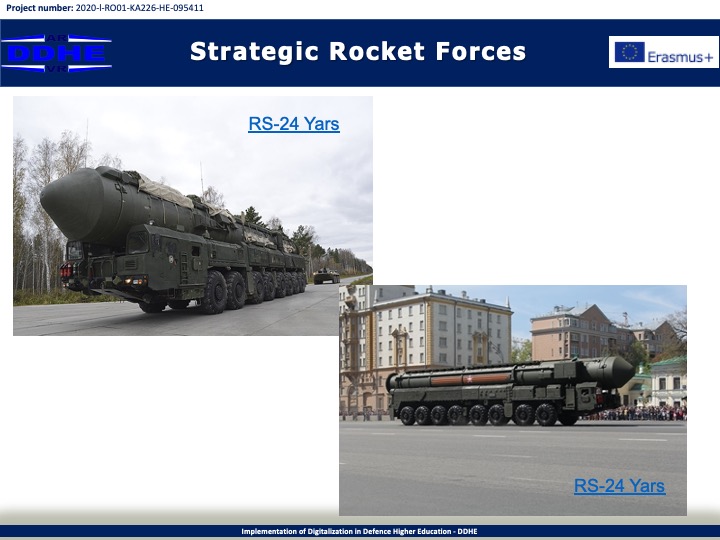The Strategic Rocket Forces of the Russian Federation or the Strategic Missile Forces of the Russian Federation (RVSN RF; Russian: Ракетные войска стратегического назначения Российской Федерации (РВСН РФ), romanized: Raketnye voyska strategicheskogo naznacheniya Rossiyskoy Federatsii, lit. 'Strategic Purpose Rocketry Troops') are a separate-troops branch of the Russian Armed Forces that control Russia's land-based intercontinental ballistic missiles (ICBMs).
The Strategic Rocket Forces was created on 17 December 1959 as part of the Soviet Armed Forces as the main force intended for attacking an enemy's offensive nuclear weapons, military facilities, and industrial infrastructure. They operated all Soviet nuclear ground-based intercontinental, intermediate-range ballistic missile, and medium-range ballistic missile with ranges over 1,000 kilometers. After the Soviet Union collapsed in 1991, assets of the Strategic Rocket Forces were in the territories of several new states in addition to Russia, with armed nuclear missile silos in Belarus, Kazakhstan and Ukraine. The three of them transferred their missiles to Russia for destruction and they all joined the Nuclear Non-Proliferation Treaty.
Complementary strategic forces within Russia include the Russian Aerospace Forces' Long Range Aviation and the Russian Navy's ballistic missile submarines. Together the three bodies form Russia's nuclear triad.
The main RVSN command post is at Kuntsevo in the suburbs of Moscow. The alternate command post is at Kosvinsky Mountain in the Urals.
Female cadets have started to join the Peter the Great Strategic Missile Forces Academy. RVSN institutes also exist at Serpukhov and Rostov-on-Don. An ICBM test impact range is located in the Far East, the Kura Test Range. This has been under Aerospace Defence Forces' command since 2010.
The Strategic Missile Forces operate four distinct missile systems. The oldest system is the silo-based R-36M2 / SS-18 Satan. It carries ten warheads. The last missile will be in service until 2020.
The second system is the silo-based UR-100NUTTH / SS-19 Stiletto. The last Stiletto missiles in service with six warheads each will be removed by 2019. The third system, the single warhead mobile RT-2PM Topol / SS-25 Sickle are planned to be decommissioned by 2019.
A new missile entering service is the RT-2UTTH Topol-M / SS-27 Sickle B with single warhead, of which 60 are silo-based and 18 are mobile. Some new missiles will be added in the future. The first upgraded Topol-M called RS-24 Yars, carrying three warheads, was commissioned in 2010. In July 2011 the first mobile regiment with nine missiles was completed. From 2012 to 2017, about 80 ICBMs were placed in active duty. The RF Defense Minister said in December 2021 that 89.1% of the country's nuclear forces was modern.
